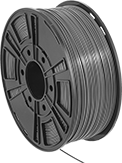UV- and Impact-Resistant ASA 3D Printer Filaments
 | ||
Best for outdoor use, parts made from these ASA filaments are UV resistant, so they won't warp or crack from prolonged sun exposure. They’re also durable, so they absorb impact without breaking and won’t degrade when heated.
Use with fused filament fabrication (FFF) 3D printer. These filaments have a high melting point and must be printed onto a heated bed. Without it, parts will cool too quickly and warp. These filaments also release fumes as they are printed, so use an enclosed printer or a fume exhauster to ventilate them.
Tensile strength is the best measure of a filament's overall strength. Similar to the stress applied on a rope during a game of tug-of-war, it's the amount of pulling force a material can handle before breaking. A higher rating means a stronger filament. A tensile strength of 5,000 psi and above is considered good; 12,000 psi and above is excellent.
Maximum exposure temperature is the point at which a printed part will begin to deform. Above this temperature, your printed parts will start to lose structural integrity.
Spool | |||||||||||
|---|---|---|---|---|---|---|---|---|---|---|---|
| Dia., mm | Printing Temp. | For Printer Bed Temp. | Tensile Strength | Max. Exposure Temp. | For Min. Nozzle Opening Dia., mm | Dia., mm | Dp., mm | Wt., g | Color | Each | |
ASA Plastic | |||||||||||
| 1.75 | 235° to 255° C 455° to 491° F | 90° to 110° C 194° to 230° F | 6,520 psi (Good) | 95° C 203° F | 0.4 | 200 | 75 | 1,000 | 00000000 | 000000 | |
| 2.85 | 235° to 255° C 455° to 491° F | 90° to 110° C 194° to 230° F | 6,520 psi (Good) | 87° C 188° F | 0.4 | 198 | 78 | 1,000 | 00000000 | 00000 | |


























